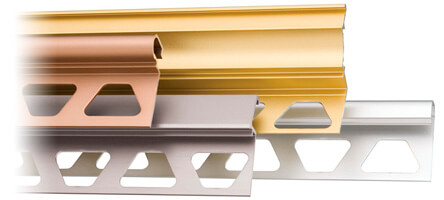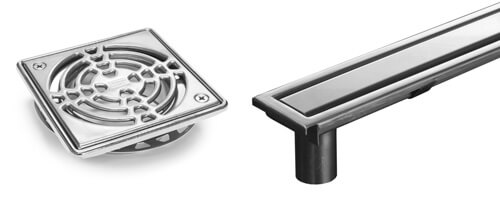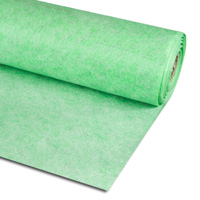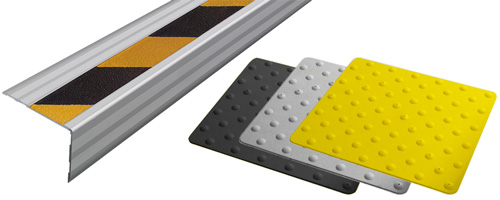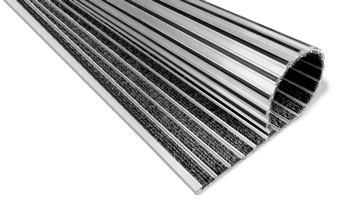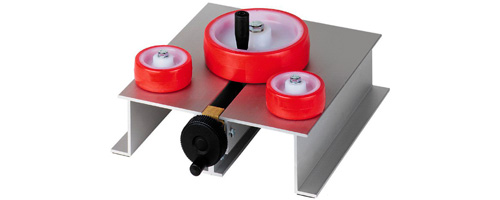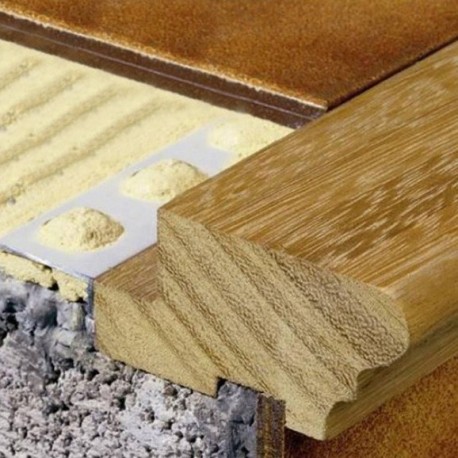Tread edge profiles for the finishing of stairs tiled with ceramics or any other type of flooring, providing a noble and elegant touch.
Available stair nosings of various models with different footprint measurements. This footprint is made of carved natural wood joined to a die-cut aluminum fixing wing with octagon-shaped perforations that allow the passage of adherent material, ensuring optimum installation and useful life.
Stair nosing trims available in woods suitable for indoors and outdoors. It has complementary pieces for corners and sides to achieve a perfect finish.
Its meticulous assembly and the union between the aluminum fixing wing and the wood by means of adhesives and appropriate screws, represent an added guarantee to these profiles.
The stair edging profiles are presented protected by a protective film that prevents stains and damage during installation and transport, which should not be removed until the installation is complete.
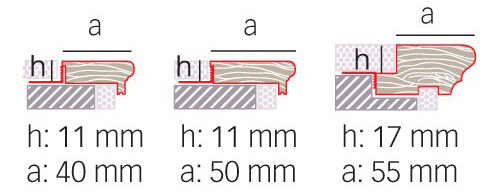
Wood features
- Step edge composed of natural wood, untreated. For correct use, it must be treated after placement according to the type of wood and its use outdoors or indoors.
- Store the Wood in dry places and in a horizontal position, never vertically.
- The tolerance in the dimensions of the wooden profiles correspond to IT14 quality.
- The heights of the wood can undergo a variation of +/- 5% on the measures indicated due to the characteristics of the wood.
- The color of natural wood is uneven and gives it a unique look. Note that shade and grain variations may appear even in the same profile. These variations are characteristic of authentic wood.
- The curvature of the wood is a characteristic of natural material. For a perfect hold it is recommended to apply pressure to the profile until the bonding material sets. It is also recommended to read the instructions on the back of each profile before proceeding with its placement.
Characteristics of natural woods *
Iroko
- African teak. Wood classified as very durable against the action of fungi and termites.
- The color is yellowish brown, which turns golden brown, when exposed to light.
- Density 630 –670 Kg / m3.
- It is used both indoors and outdoors.
Tali
- Of African origin, its color varies from yellowish brown to reddish brown, which darkens depending on its exposure to light.
- It has good resistance to dilute mineral acids.
- Density 890 –960 Kg / m3.
- Especially recommended for outdoor use.
Guinea mahogany
- Its color varies from brown to reddish brown, which darkens depending on its exposure to light.
- The woody radii are fine, wavy in shape and staggered.
- African origin.
- Especially recommended for outdoor use.
Oak
- Its natural color varies from light brown to pale yellow.
- Woody rays are visible and multiseriate
- American origin. Density 670 –770 Kg / m3.
- Commonly used in furniture and joinery
- Recommended for indoor use
* The manufacturer reserves the right to change without prior notice the type of wood offered for another of similar characteristics, in case of difficulties in importing exotic woods
Slip resistance
Ceramic tiles are subject to the requirement of the Basic Document DB-SU, Safety of use, SU1: Safety against the risk of falls, belonging to the Technical Building Code.
The CTE was approved by Royal Decree 214/2006, published in the B.O.E. of March 28, 2006, and modified by Royal Decree 137/2007 of October 19, 2007, published in the B.O.E. from October 23, 2007.
The objective of the basic requirement "Safety of use" is to reduce to acceptable limits the risk that the users of a building will suffer immediate damage during its intended use, as a consequence of the characteristics of its project, construction, use and maintenance.
The DB-SU 1: Safety against the risk of falls requires limiting the risk that users suffer falls, for which the floors will be adequate to favor that people do not slip, trip or make mobility difficult.
Area of application
The conditions established in DB-SU 1 apply to the floors of buildings or areas of use:
- Health: clinics, hospitals, health centers ...
- Teacher: universities, colleges ...
- Commercial: markets, shopping malls, hypermarkets, stores ...
- Administrative: offices, banks ...
- Parking lots
- Public attendance: Building or establishment intended for cultural use (intended for restoration, shows, meeting, recreation, sport, auditoriums, games and the like), religious and for the transport of people.
Restricted Use areas are excluded from these requirements: Use of circulation areas or elements limited to a maximum of 10 people who have the character of habitual users, including the interior of homes, but excluding common areas of residential buildings .
The CTE does not expressly include the Residential Residential Use and Public Residential Use areas, so these cases are under the requirements of territorial regulations, whether autonomous or municipal. In most cases, territorial regulations include residential areas in the scope of the CTE.
Residential Use Housing
Building or area intended for permanent accommodation, whatever the type of building: single-family home, apartment or apartment building, etc.
Public Residential Use
Building or establishment intended to provide temporary accommodation, run by a holder of the activity different from the group of occupants and who can have common services, such as cleaning, dining, laundry, venues for meetings and shows, sports, etc. Includes hotels, hostels, residences, pensions, tourist apartments, etc.
Classification of soils according to their slipperyness
| Slip resistance (Rd) (Rd) | Class |
| Rd ≤ 15 | 0 |
| 15 < Rd ≤ 35 | 1 |
| 35 < Rd ≤ 45 | 2 |
| Rd > 45 | 3 |
Classification of soils according to their location
| Location | Class |
| Dry interior areas | 2 |
| Humid interior areas, such as entrances to buildings from outer space (1), covered terraces, changing rooms, showers, bathrooms, toilets, kitchens, etc ... | 3 |
| Indoor areas where, in addition to water, there may be agents (greases, lubricants, etc.) that reduce slip resistance, such as industrial kitchens, slaughterhouses, parking lots, areas of industrial use, etc. | 3 |
| Exterior areas. Pools (2) | 3 |
(2) In areas intended for barefoot users and at the bottom of the vessels, in areas where the depth does not exceed 1.5 m
Placement
- First of all, read carefully the installation instructions labeled in the profile.
- Spread abundant material on the riser of the step and lay the flooring.
- Then spread the gripping material on the tread tread and align the profile on the vertex of the step, so that it rests on the riser so as not to leave the profile unsupported (never cantilever, the lever effect could tear off the tread and tiling). Press the profile to ensure perfect fixation, ensuring that the gripping material passes through the die, designed for this purpose.
- Then place the flooring on the fixing wing.
- Finally, carefully clean any possible remains of agarrey material and remove the protective film.
Wood treatment and maintenance
The wood must be protected from the action of the sun, wear by friction, insects and fungi, and variations in humidity and temperature, and can be done by applying different products: Varnishes, Paints and Lasures or Pore Varnishes open.
- Varnishes: They form a solid and rigid film that cannot follow the movements of wood, so it breaks and flakes, it is also transparent, so it does not protect wood from the action of sunlight. It is not recommended for outdoor woods.
- Paints: They form an opaque film on the wood and can follow the movements of the wood depending on the flexibility of the resins used. The paint pigments protect the resin and prevent rapid degradation, its duration is longer than in the case of varnishes, but over time, breakage of the paint layer is inevitable. In case of using paints, use those specifically designed for carpentry.
- Lasures or open pore varnishes: They are coating products provided with pigments that do not form a film or layer on the wood and are capable of following the movements of the wood. Its duration is intermediate between varnishes and paints. The pigments that the lasures incorporate protect the resin from photodegradation as well as from the action of water, preventing its rapid deterioration, and there is a wide variety of classes (satin, matte, with UV filters, colored, colorless, etc.). These three types of protectors must be applied after the initial primer of a primer, which can be applied by spraying or brushing.
In the case of the profiles, it is recommended to apply it after its placement, in order not to remove the protective film that prevents it from deteriorating during its assembly. If it is done with a brush, you must give several coats at the beginning so that it penetrates well, and insist on the ends, that is, where the fiber is perpendicular to the surface, normally the ends. Afterwards, it will only be necessary to re-give the protector once a year in places that are highly exposed to the sun, since it dries the wood and opens the pore. Good sanding before application will promote absorption.
Cleaning tips
- If during the work the piece of wood is stained, clean or sand the wood. Never use abrasive products (lyes, salfumán, soda ...), but soap and water using an aluminum sponge or esparto. Cleaning is recommended as many times as necessary, but it is not recommended to "soak" the wood, as it could crack when dried.
- Clean water does not stain the wood, if localized stains are noticed on the wood, it is best to use a damp cloth.
- If the wood is waterproofed, clean in a similar way to cleaning the floor, wringing the mop very well, and using mild cleaning products that do not attack the wood.

